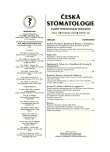-
Medical journals
- Career
Modification of Dentine Surface Using a Pulsed Nd:YAG Laser
Authors: Z. Zapletalová 1; J. Peřina jr. 2; H. Chmelíčková 2; R. Novotný 3; M. Stranyánek 2
Authors‘ workplace: Klinika zubního lékařství LF UP a FN, Olomouc přednosta prof. MUDr. M. Eber, CSc. 1; Spojená laboratoř optiky, Fyzikální ústav AV ČR, Olomouc vedoucí prof. RNDr. M. Hrabovský, DrSc. 2; Pracoviště mikroskopických metod LF UP, Olomouc přednosta prof. MUDr. V. Lichnovský, DrSc. 3
Published in: Česká stomatologie / Praktické zubní lékařství, ročník 105, 2005, 6, s. 159-164
Overview
Dentine hypersensitivity is a common complaint of adult patients in dental office. It is a source of uncomfortable feelings or pain and from 10 to 15 percent of population suffers from it. Sealing of dentinal tubules opened to the outside is one of the methods of treatment of dentine hypersensitivity. When dentine is irradiated by a radiation of Nd:YAG laser, the dentine surface can be melted. After cooling, the melted surface forms a glazed and non-porous surface that can partly or fully obturate orifices of dentinal tubules. Dentine samples prepared from extracted human third molars were irradiated by the light from Nd:YAG laser system LASAG KLS 246-102. One hundred and nine dentine samples in the form of 2 to 3 mm high discs were exposed by laser pulses with energies from 20 mJ to 250 mJ per pulse. A pulsed regime of operation with repetition rate of 15 Hz and pulse duration of 0.3 ms was used; beam diameter in the focus of an optical fiber was 0.3 and 0.6 mm. Samples moved with respect to the fixed head of an optical laser system along a serpentine path that assured the overlap of 50 percent of the adjacent beam spots on the surface. After a series of experiments on relatively flat artificially-prepared cross-section surfaces of dentine discs, we moved to the samples prepared from outer parts of roots and having convex surfaces. We have applied dye agents (tatrazine, carmine indigo, erythrosine and methylene blue) with suitable spectra (with respect the wavelength of laser radiation) on dentine surfaces in order to increase absorption of laser energy. Changes of dentine surfaces were observed using Scanning Electron Microscopy (SEM).
Sealing of dentinal tubules were observed already when a surface was exposed to a beam with diameter of 0.6 mm and energies of 30 mJ per pulse in several subsequent exposures. An upper bound for laser exposure is reached when pulses with energies of 90 mJ per pulse having beam diameter of 0.3 mm and four-fold exposure are applied. In both cases dentine surfaces were covered by erythrosin solution in water. Laser radiation generated from a standard pulsed Nd:YAG laser with a precise control of its parameters can be used for dentine surface modification and reaching tubules occlusion.Key words:
dentine hypersensitivity – dentinal tubules – Nd:YAG laser – melting of dentine surface
Labels
Maxillofacial surgery Orthodontics Dental medicine
Article was published inCzech Dental Journal

2005 Issue 6-
All articles in this issue
- Biological Tests of Chromium-cobalt Alloy Coated with Zirconium Nitride and Titanium Nitride
- Complications and Disorders in Healing of Extraction Wound
- Modification of Dentine Surface Using a Pulsed Nd:YAG Laser
- Changing Oral Health Status in Seniors in the Czech Republic between 1987 and 2003
- Application of Restriction Analysis of the Gene for 16S rRNA for Verification of Species Identity in Important Oral Microorganisms I. Viridans Streptococci
- A Contribution to the Etiology of Diseases of Temporomandibular Joint
- Periodontal Cyst
- Clinical Profile of the Third Molar Predicting the Highest Risk of the Origin of Pericoronitis
- Evaluation of the program HEALTHY TEETH after Four Years of Implementation at the Primary Schools in the Czech Republic
- A Contribution to Ultrasound Preparation of Hard Dental Tiss
- Czech Dental Journal
- Journal archive
- Current issue
- Online only
- About the journal
Most read in this issue- Periodontal Cyst
- Complications and Disorders in Healing of Extraction Wound
- A Contribution to the Etiology of Diseases of Temporomandibular Joint
- A Contribution to Ultrasound Preparation of Hard Dental Tiss
Login#ADS_BOTTOM_SCRIPTS#Forgotten passwordEnter the email address that you registered with. We will send you instructions on how to set a new password.
- Career

